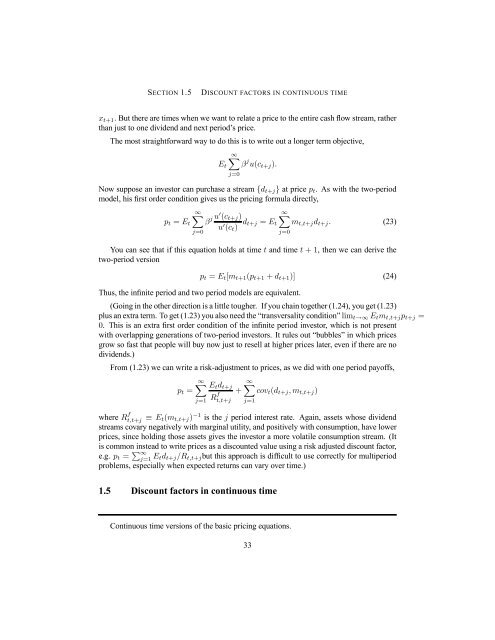Asset Pricing John H. Cochrane June 12, 2000
Asset Pricing John H. Cochrane June 12, 2000
Asset Pricing John H. Cochrane June 12, 2000
You also want an ePaper? Increase the reach of your titles
YUMPU automatically turns print PDFs into web optimized ePapers that Google loves.
SECTION 1.5 DISCOUNT FACTORS IN CONTINUOUS TIME<br />
xt+1. But there are times when we want to relate a price to the entire cash flow stream, rather<br />
than just to one dividend and next period’s price.<br />
The most straightforward way to do this is to write out a longer term objective,<br />
∞X<br />
Et β<br />
j=0<br />
j u(ct+j).<br />
Now suppose an investor can purchase a stream {dt+j} at price pt. As with the two-period<br />
model, his first order condition gives us the pricing formula directly,<br />
pt = Et<br />
j=0<br />
∞X<br />
β j u0 (ct+j)<br />
u0 (ct) dt+j = Et<br />
j=0<br />
∞X<br />
mt,t+jdt+j. (23)<br />
You can see that if this equation holds at time t and time t +1, then we can derive the<br />
two-period version<br />
pt = Et[mt+1(pt+1 + dt+1)] (24)<br />
Thus, the infinite period and two period models are equivalent.<br />
(Going in the other direction is a little tougher. If you chain together (1.24), you get (1.23)<br />
plus an extra term. To get (1.23) you also need the “transversality condition” limt→∞ Etmt,t+jpt+j =<br />
0. This is an extra first order condition of the infinite period investor, which is not present<br />
with overlapping generations of two-period investors. It rules out “bubbles” in which prices<br />
grow so fast that people will buy now just to resell at higher prices later, even if there are no<br />
dividends.)<br />
From (1.23) we can write a risk-adjustment to prices, as we did with one period payoffs,<br />
∞X<br />
∞X<br />
pt =<br />
+ covt(dt+j,mt,t+j)<br />
j=1<br />
Etdt+j<br />
R f<br />
t,t+j<br />
j=1<br />
where R f<br />
t,t+j ≡ Et(mt,t+j) −1 is the j period interest rate. Again, assets whose dividend<br />
streams covary negatively with marginal utility, and positively with consumption, have lower<br />
prices, since holding those assets gives the investor a more volatile consumption stream. (It<br />
is common instead to write prices as a discounted value using a risk adjusted discount factor,<br />
e.g. pt = P∞ j=1 Etdt+j/Rt,t+jbut this approach is difficult to use correctly for multiperiod<br />
problems, especially when expected returns can vary over time.)<br />
1.5 Discount factors in continuous time<br />
Continuous time versions of the basic pricing equations.<br />
33
















